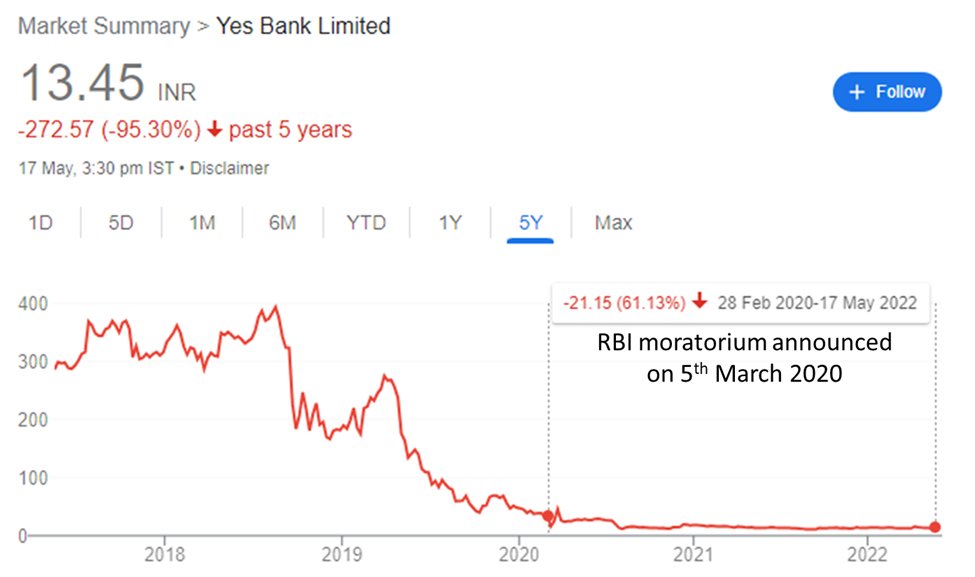Failure is life’s best teacher & loss is stock market’s best teacher!
I lost 80% of my capital in a #Nifty50 stock in just 1 year!
It is my life's worst investment till date & Covid had no role in it!
Here are my Top 5 lessons from my biggest mistake!
Thread 🧵👇
(1/9)

I lost 80% of my capital in a #Nifty50 stock in just 1 year!
It is my life's worst investment till date & Covid had no role in it!
Here are my Top 5 lessons from my biggest mistake!
Thread 🧵👇
(1/9)


Lesson 1 – Never average down with deteriorating fundamentals
I bought #YesBank in Sep'18. It was in Nifty since 2015 & reported 4k cr PAT in FY18.
1 week later, RBI declined CEO Rana Kapoor’s extension & stock crashed 50%🔻
I kept averaging looking at past performance
(2/9)
I bought #YesBank in Sep'18. It was in Nifty since 2015 & reported 4k cr PAT in FY18.
1 week later, RBI declined CEO Rana Kapoor’s extension & stock crashed 50%🔻
I kept averaging looking at past performance
(2/9)

In Jan'19, new CEO announcement led to good recovery in stock price.
I thought market is happy and bank is back on track.
But in April, bank declared shocking Q4FY19 numbers.
A loss of 1500 cr which was the 1st ever in the bank’s history!
Stock crashed 50% again 📉
(3/9)
I thought market is happy and bank is back on track.
But in April, bank declared shocking Q4FY19 numbers.
A loss of 1500 cr which was the 1st ever in the bank’s history!
Stock crashed 50% again 📉
(3/9)

Somehow I still justified my holding & didn't book a loss.
I went with the TV/market narrative that a new management often cleans up books of accounts with a “kitchen sinking” qtr.
My senses had taken leave off me so I averaged further into deteriorating fundamentals.
(4/9)
I went with the TV/market narrative that a new management often cleans up books of accounts with a “kitchen sinking” qtr.
My senses had taken leave off me so I averaged further into deteriorating fundamentals.
(4/9)

Lesson 2 – Never listen to TV experts
I made another big mistake by listening to TV experts talking how banks in 🇮🇳 never fail. And I kept adding.
A big learning, “I” need to be the final authority on my investments, not anyone else no matter their experience or wisdom.
(5/9)
I made another big mistake by listening to TV experts talking how banks in 🇮🇳 never fail. And I kept adding.
A big learning, “I” need to be the final authority on my investments, not anyone else no matter their experience or wisdom.
(5/9)

Lesson 3 – Never act on market speculation
Daily news harped about potential foreign investors taking over the bank.
I thought a big PE firm or FII will soon save #YesBank like a knight in shining armor.
I only compounded my earlier mistakes by averaging aggressively 😢
(6/9)


Daily news harped about potential foreign investors taking over the bank.
I thought a big PE firm or FII will soon save #YesBank like a knight in shining armor.
I only compounded my earlier mistakes by averaging aggressively 😢
(6/9)



Lesson 4 – Swallow your ego and book a loss (if writing is on the wall)
I finally did one thing right!
I exited Yes Bank at Rs.30 immediately after the RBI moratorium announcement on 5 Mar 2020.
I saved min. 10% of capital as the stock halved 50% even from that time.
(7/9)
I finally did one thing right!
I exited Yes Bank at Rs.30 immediately after the RBI moratorium announcement on 5 Mar 2020.
I saved min. 10% of capital as the stock halved 50% even from that time.
(7/9)

Lesson 5 – Avoid big bets in leveraged financials
I invested 10% of PF in #YesBank & lost 80% in just 1 year.
Leveraged financials are very risky because of high debt to equity.
They are the first ones to get thrashed in any economic crisis (ex: Demon, ILFS, Covid)
(8/9)
I invested 10% of PF in #YesBank & lost 80% in just 1 year.
Leveraged financials are very risky because of high debt to equity.
They are the first ones to get thrashed in any economic crisis (ex: Demon, ILFS, Covid)
(8/9)

Top 5 Lessons Summary
1.Never avg down with deteriorating fundamentals
2.Never listen to TV experts
3.Never act on market speculation
4.Swallow your ego & book a loss
5.Avoid big bets in leveraged financials
Share this 🧵to educate & prevent retail from these mistakes!
END
1.Never avg down with deteriorating fundamentals
2.Never listen to TV experts
3.Never act on market speculation
4.Swallow your ego & book a loss
5.Avoid big bets in leveraged financials
Share this 🧵to educate & prevent retail from these mistakes!
END
• • •
Missing some Tweet in this thread? You can try to
force a refresh
















